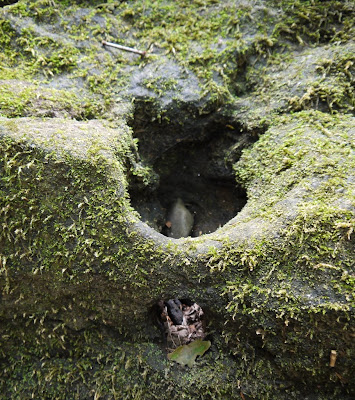 It's dry. Very dry. The brook that normally cascades down the north side of Sleeping Giant to Tuttle Road along the Red Circle Trail was bone dry in many places, marked only by a line of moss. Above is the Gorge.
It's dry. Very dry. The brook that normally cascades down the north side of Sleeping Giant to Tuttle Road along the Red Circle Trail was bone dry in many places, marked only by a line of moss. Above is the Gorge. This was a waterfall last April. Seeing the exposed bed of the stream was interesting, though.
This was a waterfall last April. Seeing the exposed bed of the stream was interesting, though. Here was a hole formed by water that you normally would never know is there. Water goes in the top and out the bottom.
Here was a hole formed by water that you normally would never know is there. Water goes in the top and out the bottom. Here's another hole formed by water, looking down the river bed.
Here's another hole formed by water, looking down the river bed. The bedrock type change as you go up the hill. First there is the very soft red-brown shale. You don't see much of it because it's so soft and erodable.
The bedrock type change as you go up the hill. First there is the very soft red-brown shale. You don't see much of it because it's so soft and erodable. 
Further up, there is lots of conglomerate, which looks like concrete. It's just another sedimentary rock, but with assorted sized grains including some gravel. It's a reflection of the fast erosion that took place when Connecticut almost became the Atlantic Ocean during the Triassic. We had all sorts of crazy things going on: Earthquakes, volcanoes, dinosaurs... the east side of the state was getting pulled away from the west side, opening up huge fissures where vast amounts of lava spilled into the CT Valley. And then it all just stopped and the Atlantic opened up further east.
 Further up the brook, you hit that Triassic magma, all broken up, and very, very hard.
Further up the brook, you hit that Triassic magma, all broken up, and very, very hard.  Picking up a rock in the stream bed, I found several little salamanders taking refuge, as well as a flattened out Green Frog.
Picking up a rock in the stream bed, I found several little salamanders taking refuge, as well as a flattened out Green Frog. There were a few pools remaining. A tiny juvenile salamander is just visible. I believe it's a Yellow Spotted Salamander.
There were a few pools remaining. A tiny juvenile salamander is just visible. I believe it's a Yellow Spotted Salamander.


No comments:
Post a Comment